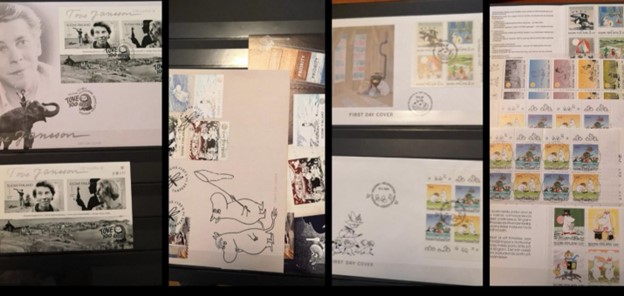Click here for text in English –>
Muumimukien ja muumituotteiden keräily on kovassa suosiossa. Muumipostimerkkien ja -tuotteiden aiheet noudattelevat Tove Janssonin muumitarinoiden kokoelmaa. Ensimmäiset postimerkit julkaistiin v. 1992 ja nämä ensipäivänkuoret olivat mukana v. 1993 NORDIA-näyttelyssä (kuva 2).
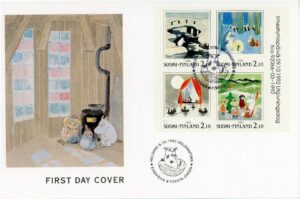
Suomen postimerkeissä Muumit-aiheesta on julkaistu erilaisia merkkejä 70 kappaletta. Julkaisut Suomen postimerkeissä ovat vuosilta 1992 (NORDEA 93 4 kpl), 1994 (2 kpl), 1998 (4 kpl), 2000 (4 kpl), 2003 (Muumit ja taikatalvi 6 kpl), 2004 (Nukkapintainen postimerkki ns. karvamuumi 1 kpl), 2007 (Muumilaakson kesä 6 kpl), 2009 (Muumit sarjakuvissa 6 kpl), 2011 (Kuinkas sitten kävikään? 6 kpl), 2013 (Muumisuosikit 6 kpl), 2015 (Europa Vanhat lelut 2 kpl), 2017 (Muumien aikamatka 5 kpl), 2019 (Neuvoja hyvään elämään 6 kpl), 2020 (Meidän meri 6 kpl) ja 2022 (Muumit ABC 6 kpl). Lisäksi Tove Janssonin 100-vuotisjuhlan kunniaksi 2 merkkiä vuodelta 2014. Samoin Suomeen kuuluva Ahvenanmaa julkaisi 2007 merkin (Tove Jansson).
Blogin otsikkokuvassa näkyy kokoelmaani vuosien 1992, 1994, 1998 sekä 2014, 2017 Muumit- ja 2014 Tove Jansson-postimerkkivihkoja ja ensipäivänkuoria.
Suomalaiset Muumipostimerkit aikajärjestyksessä
Seuraavassa olen kuvannut Muumipostimerkkeihin ja Tove Janssonin elämään liittyviä yksityiskohtia poimittuna Suomen postilaitoksen julkaisemista ”Postimerkkivuosi”-vuosikirjoista merkkien julkaisuvuosilta, LaPe- postimerkkiluetteloista, Postin tiedotteista sekä moomin.com-sivustolta. Merkkisarjojen kuvat on skannattu omista kokoelmista.
Muumiaihe tulee siis taitelija Tove Janssonilta (1914 – 2001). Hän oli monipuolinen kuvataiteilija, joka teki uransa aikana paljon maalauksia, grafiikkaa (mm. muumit) ja julkisia töitä. Hän kirjoitti myös muita kirjoja ja novelleja, viimeisimmän novellikokoelmansa 84-vuotiaana vuonna 1998. Ensimmäinen muumikirja oli v. 1945 “Muumit ja suuri tuhotulva”. Kahden ensimmäisen muumikirjan nosteen edesauttamana, Muumipeikko-sarjakuva ilmestyi yli 40 maassa vuosina 1954 – 1975, alkaen brittiläisestä The Evening News-iltapäivälehdestä. Muumit eivät ole olleet pelkästään lapsille, sillä sarjakuvan odotettiin myös satirisoivan meidän ns. sivistynyttä elämäntapaamme. Sarjakuvan käsikirjoittajana ja kääntäjänä toimi veli Lars Jansson, joka jatkoi sarjakuvan tekemistä Toven lopetettua. Muumikirjoja on käännetty yli 30 kielelle.
Vuonna 2021 sai ensi-iltansa ”Tove”-elokuva, jossa pääosaa esitti Alma Pöysti. Elokuva kertoo sekä Toven työuran että yksityiselämän kulminaatiopisteistä.

Vuoden 1992 postimerkkisarjan (kuva 3 yllä) teki Janssonin luottotaiteilija Pirkko Vahtero Tove Janssonin töiden pohjalta. Samoihin ilmestyi Japanissa tehty animaatiosarja (syksystä 1991 asti), jota omat lapsenikin katselivat ahkerasti. Sarjan tunnusmusiikin ”Käy Muumilaaksoon” tunnistavat varmasti monet vieläkin.

Vuoden 1994 vihkon (4*2 merkkiä, kuva 4.) kansikuva on tarinasta ”Taikurinhattu” ja postimerkit saduista ”Vaarallinen juhannus” ja ”Taikatalvi”. Muumeista oli kasvanut suomalainen vientituote. Monin eri tavoin palkittu ja tunnustettu Tove Jansson sai professorin arvonimen vuonna 1995.
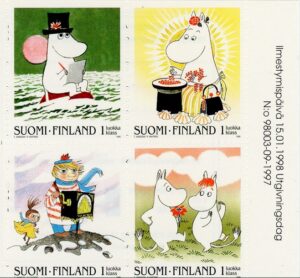
Vuoden 1998 vihkon (kuva 5.) kansikuva on sarjakuvasta ”Muumiperhe ja meri” sekä kahden merkin kuva-aiheet kirjoista ”Taikatalvi” ja ”Kuinkas sitten kävikään” sekä kaksi muuta Tove Janssonin yksittäispiirroksia. Toteutuksesta vastaten jälleen Pirkko Vahtero. Naantalin muumimaailma oli toiminnassa ja Muumien Pääpostista sai erikoisleiman.
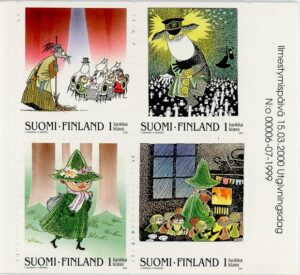
Vuoden 2000 postimerkkien kuvat ovat kaikki kirjasta Vaarallinen juhannus. Pirkko Vahtero vastasi kuvien värityksestä. Tove Jansson kuoli Helsingissä 27.6.2001.
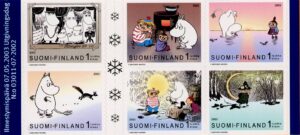
Vuoden 2003 postimerkkien aihe on saturomaanista Taikatalvi, joka ilmestyi vuonna 1957. Kuvat postimerkkeihin valitsi Janssonin ystävä, professori Tuulikki Pietilä. Hän on itsekin yksi muumitarinoiden hahmo: Tuu-tikki. Jokaisella kuudella postimerkillä on oma nimensä Taikatalven tarinasta.
Seuraavassa kuvassa näkyvät ensipäiväkuoret 1994 – 2003 kollaasina.
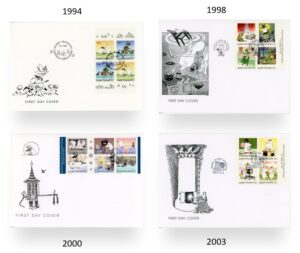

9.8.2004 oli nukkapintaisen postimerkin, ”Karvamuumin” aika, kun Tove Janssonin syntymästä tuli 90 vuotta. Merkkipäivän johdosta julkaistiin myös 10 € nimellisarvoinen hopeinen juhlaraha. Paperin pinta tuo mieleen muumin pehmeän turkin. Postimerkin etualalla on Muumipeikko ja taustalla Nuuskamuikkunen. Postimerkin suunnitteli graafikko Päivi Vainionpää.
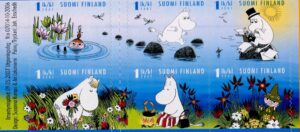
Vuonna 2007 oli vuorossa tarina Muumilaakson kesä. Kuuden merkin kokonaisuuden rakensivat graafiset suunnittelijat Susanna Rumpu ja Ari Lakaniemi. Merkkien piirrokset on julkaistu teoksissa Vaarallinen juhannus ja Muumisisarukset.
Vuonna 2007 julkaistiin myös Ahvenanmaan Tove Jansson- merkki.
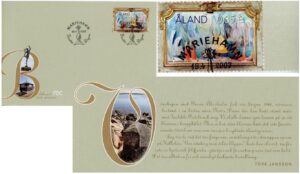
Vuoden 2009 merkkien leikkisän graafisen ilmeen toteutti Päivi Vainionpää.
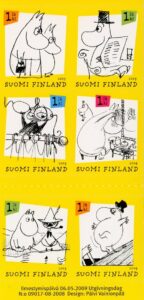
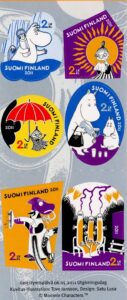
Vuoden 2011 vihko on tarinasta Kuinkas sitten kävikään?Kirja Mymmelistä, Muumipeikosta ja Pikku Myystä on ensimmäinen Muumikuvakirja ja klassikko. Se syntyi vuonna 1951 ja oli ensimmäinen suomennettu teos (aiemmin ruotsiksi ja englanniksi). Teos poikkesi muista lastenkirjoista rakenteensa sekä kuvallisten ja typografisten kokeilujensa vuoksi. Suomentaja Hannes Korppi-Anttila keksi hahmoille suomenkieliset nimet. Kirja voitti useita palkintoja. Postimerkkivihkon toteutti graafinen suunnittelija ja kuvittaja Satu Lusa. Vihkon kannessa on kirjan etukannen kurkistuskuva. Postimerkit (2 lk) saivat muotonsa kirjan kurkistusaukoista.
Seuraavassa kuvassa näkyvät vuosien 2004 – 2011 ensipäiväkuoret.
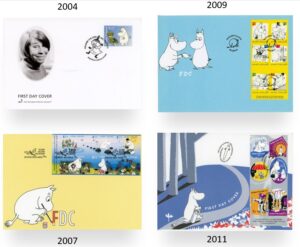

Vuoden 2013 Muumisuosikit-vihkossa näkyvät puhekuplat, johtuen siitä, että englantilainen iltapäivälehti The Evening News niitä edellytti Muumi-sarjakuviin. Samoin kuin kaikki merkkien aiheet ovat näistä sarjakuvista. Vuonna 1959 Tove Jansson siirsi vastuun lehtisarjakuvien tuottamisesta veljelleen Lars Janssonille, joka jatkoi työtä v. 1975 asti. Vihkon vauhdikkaat ja ilmeikkäät hahmot ilmentävät elämäniloa. Vihkon toteutti graafikko Satu Lusa. Piirroshahmojen päälle on painettu silkkilakkaus.
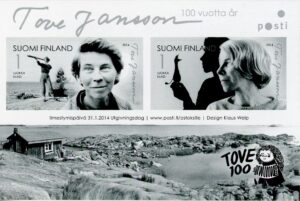
Vuonna 2014 juhlittiin Tove Janssonin syntymän 100-vuotispäivää. Kahdessa 1. luokan postimerkissä on kuvattu saaristoa, jossa Jansson vietti paljon aikaa lapsuudestaan lähtien. Juhlan kunniaksi postimerkkejä myytiin myös erillisessä kansiossa. Samoin 2 € erikoiseuro sekä 10 € ja 20 € hopeiset juhlarahat julkaistiin (kuvat alempana). Muumihahmoista merkkiin on kuvattu Nipsu varjokuvana Janssonin kädessä. Postimerkkien suunnittelusta vastasi graafikko Klaus Welp.

Vuoden 2015 merkkipari kuvastaa Muumilelujen historiaa, joka alkaa 1950-luvulta. Suunnittelijana toimi Klaus Welp. Merkeissä esiintyvät Hemulin äiti, Muumipeikko. Vilijonkka, Nipsu, Haisuli ja Muumipappa. Merkkien lelut on valmistanut Atelier Fauni, joka oli ensimmäinen muumileluja valmistanut yritys. Nämä käsintehdyt muumihahmot ovat nykyään keräilyharvinaisuuksia.

Vuoden 2017 5 kpl postimerkkejä sarja tehtiin arvoltaan postitukseen ulkomaille. Se tehtiin juhlistamaan Tampereella avattua Muumimuseota (linkki). Tove Janssonin originaalit muumikuvat on valittu merkkeihin eri vuosikymmeniltä kuvaten muumihahmojen kehittymistä vuosien myötä. Viiden ulkomaan ikimerkin vihon ovat suunnitelleet Ari Lakaniemi ja Susanna Rumpu.
Seuraavassa kuvassa näkyvät vuosien 2013 – 2017 ensipäiväkuoret.
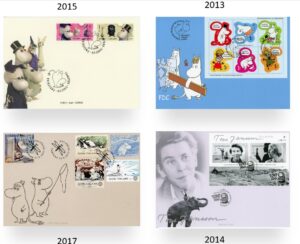

Kesäkuun 5. päivä 2019 julkaistussa Muumit: neuvoja hyvään elämään -postimerkkivihkossa oli 6 kotimaan ikimerkkiä, joista kussakin esitellään yksi Muumi-tarinoista tuttu teema: seikkailu, rohkeus, lohtu, vapaus, avoimuus ja ystävyys. Merkkien graafisesta suunnittelusta vastasi James Zambra, joka kuuluu itse Tove Janssonin sukuun. Mainittakoon, että yhdessä merkissä on Mörkö-hahmo (oikealla ylhäällä), joka sai nostetta vähän ennen julkaisua varmistuneesta Suomen kolmannesta jääkiekon maailmanmestaruudesta, avainpelaaja Marko “Mörkö” Anttilan ratkaisevista maaleista mitalipeleissä. Esimerkiksi samalla Mörkö-kuvalla Postin julkaisema kortti myytiin loppuun Tampereen Tullintorin postista. Samoin Mörkö-aiheiset muumimukit olivat jonkin aikaa loppuunmyytyjä.
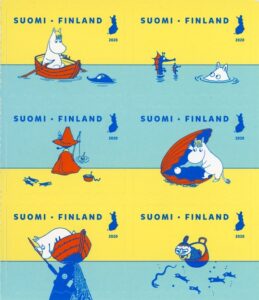
Vuoden 2020 merkkisarja julkaistiin osana #Meidänmeri/#Oursea-kampanjaa (linkki). Samalla on Muumi-tarinoiden 75-vuotisjuhlavuosi, jonka kunniaksi on ilmestynyt myös 21 kpl sarja uudelleen julkaistuja muumimukeja 75-vuotisleimalla. Postimerkkien teemana on Itämeren suojelu. James Zambran suunnittelemassa #MEIDÄNMERI-postimerkkivihkossa on 6 erilaista kotimaan ikimerkkiä.
Syyskuussa 2022 julkaistiin uudet Muumit ABC-postimerkit, jotka liittyvät Moomin Characters -yhtiön lukemista ja kirjoittamista edistävään kampanjaan. James Zambran suunnittelemissa postimerkeissä nähdään tuttuja muumihahmoja, kirjoja ja kirjaimia kirjahyllyssä. Muumit ABC -postimerkkivihkossa on 6 erilaista kotimaan ikimerkkiä.
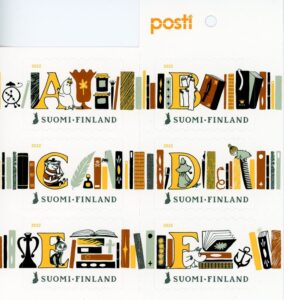
”Lukemista ja kirjoittamista edistävä teema sopii erinomaisesti postimerkkeihin, koska kirjeissä ja korteissa välitetään itse kirjoitettuja viestejä ja tunteita ihmiseltä ihmiselle. Uskon, että muumit kannustavat myös postimerkeissä yhä uusia sukupolvia kirjoittamaan ja lukemaan”, sanoo Postin Design Manager Tommi Kantola, joka vastaa postimerkkien taiteilijavalinnoista ja postimerkkitaidetöiden ohjauksesta.
Seuraavassa kuvassa ovat vuosien 2019 – 2022 ensipäiväkuoret.
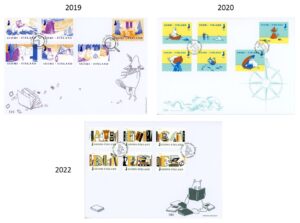
Muuta filateliaan liittyvää
Muumipostimerkkien julkaisujen yhteydessä Posti on julkaissut myös postikorttisarjoja, joiden kuva-aiheet ovat useasti olleet samat kuin postimerkkisarjoissa. Olen itse löytänyt korttisarjoja ainakin v. 1992, 1994, 1998, 2000, 2003, 2007, 2009, 2011, 2013, 2019, 2020 ja 2022 merkkijulkaisujen yhteydestä. Samoin on julkaistu ns. nuorisopassi Finlandia 88-postimerkkinäyttelyyn, sekä useampia postikirjeitä.

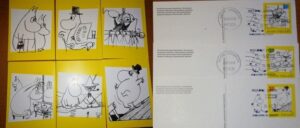
Vuoden 2020 Meidän meri-kampanjaan Paletti julkaisi ainakin 5 muumipostikortin sarjan.

Muumipostimerkkien käyttötapa on ollut sama kuin muillakin suomalaisilla postimerkeillä. Ensimmäiset sarjat olivat perinteisiä kostuttamalla liimattavia, hammasteilla toisistaan irrotettavia. Sitten siirryttiin tarrataustaisiin postimerkkeihin.
Olen siis saanut kerättyä kaikki suomalaiset Muumimerkit edellä kuvattuina variaatioina, lisäksi Ahvenanmaa (2007) sekä myös Japanin postituoreet julkaisut (2015, 2018, 2021) arkkeina. Olen kerännyt suomalaiset muumimerkit myös korteille ja kuorille siten, että niissä on joko ensipäivä-nappiloistoleima tai sitten Tampereen muumimuseon erikoisleima. Kortit ikään kuin maksimikortteina siis. Samoin tuoreet vihkojulkaisut pyrin loistoleimauttamaan kuin myös kunkin postimerkkivihkon merkit erikseen. Olen hankkinut postilähetyksiä myös Naantalin muumimaailman sekä Tampereen Metson kirjastossa sijainneen Muumilaakson erikoisleimoilla.
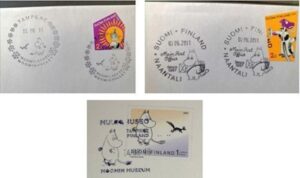

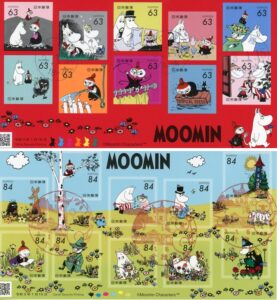
Näin Muumibuumin aikana Muumit-keräilytuotteisiin kuuluu kaikenlaista, kuten mitaleja, juhlarahoja sekä ns. numisbrief-tuotteita eli rahakirjeitä. Vuoden 2004 ns. karvamuumi-postimerkistä on ainakin julkaistu numisbrief/rahakirje, jossa on mukana 10 € Tove Jansson-juhlaraha. Hyvin useista jos ei kaikista Suomen euroaikaisista juhlarahoista (2 €- 100 €) on rahakirje julkaistu. Vuoden 2014 rahakirjeessä on Tove Janssonin 100-vuotispäivän kunniaksi julkaistu 10 € juhlaraha. Kuva tästä löytyy kirjoituksessa rahakirjeistä (linkki). Hyvä kysymys sinänsä on, ovatko numisbriefit filateliaa: ainakin niissä on Postin merkkijulkaisuja tai omakuvapostimerkkejä jopa ensipäivä-erikoisleiman kera. Toki ko. rahakirjeet voidaan sanoa tekeleiksi: niiden tarkoitus ei ole koskaan ollutkaan olla postin kuljetettavina ts. kulkeneina. Samoin niitä ei ole listattu postimerkkiluetteloissa. Monessa kirjeessä myös postileima näyttää olevan painettu, ei leimattu. Numismatiikan puolelle ne ainakin, määritelmänsä mukaan, kuuluvat.
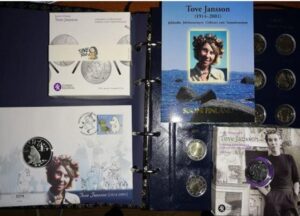
Muumilaakson tarinoista on nautittu erityisesti Japanissa, jossa aukaistiin oma The Moominvalley Park-huvipuisto v. 2019. Ko. puistossa myytäviä muumi-erikoismukeja ovat myös suomalaiset keräilijät hankkineet, kuin myös itsekin jälleenmyynnistä.
Rajallisesti saatavissa olevaa Muumin päivä-mukia jonotettiin v. 2018 yötä myöten ja asiasta raportoitiin mediassa laajasti. Samanlainen mediajulkisuus oli vuoden 2021 Muumin päivä-mukin kohdalla. Näiden välillä ei Muumin päivä-julkaisua ollut, todennäköisesti johtuen koronapandemiasta. Pandemia sotki myös vuoden 2021 julkaisua siten, että erikoismukia ei saanut kaikista Iittalan myymälöistä. Lisäksi kävi ilmi, että vuoden 2021 Vuorilla-nimisestä Norjassa julkaistusta mukista tuli tavoitellumpi keräilykohde. Muumimukeista löytyy kirjoitus tässä portaalissa (linkki).
Tove Jansson ei aikanaan vastustanut hahmojensa kaupallista käyttöä, mutta hyväksyi vain osan hänelle ehdotetuista tuoteideoista (kuten 50-luvun muumilelut, kuvattuna v. 2015 postimerkeissä). Nykyään muumihahmojen käyttöoikeuksia valvoo Janssonin perikunnan omistama Moomin Characters Ltd. ja asioin sinne itsekin, kun varmistelin filateliatuotteiden julkaisusta omissa blogeissani.
Muumipostimerkit ja juhlarahat sekä mitalit ovat varmasti yksi tapa saada keräilyharrastukselle (filatelia, numismatiikka) näkyvyyttä, vaikka toki niissä onkin ainainen riski, että määrä korvaa laadun. Esimerkiksi muumiaiheisia mitaleja sekä kultarahoja valmistetaan (Moneta Oy) niin paljon, ettei niiden perässä pysy. Jotkut niistä taitavat olla hyvin rajoitetussa myynnissä. Taloudellisestikaan niitä ei taida olla järkevää kaikkia hankkia.
Muumipostimerkkien tuotanto Suomessa jatkuu niin kauan, kuin uusia postimerkkejä vielä julkaistaan. Kuten toisessa blogissani totean (linkki), postimerkillisten kirjeiden määrä laskee koko ajan ja tulee sellainen aika, jolloin uusien postimerkkien julkaisu ei Postille Oyj:lle enää kannata. Itse veikkaan noin vuotta 2025.
Tämä blogi on päivitetty ja täydennetty versio v. 2020 julkaistusta (linkki).
All the Figures are in the Finnish version of the article above (Kuva x = Figure x).
Collecting Moomin mugs and Moomin products is very popular in Finland and some other countries, such as Japan. The themes of Moomin stamps and products follow Tove Jansson’s literary production of Moomin stories. The first stamps were published in 1992 and these first day covers were included in the 1993 NORDIA stamp exhibition in Helsinki, Finland (Figure 2).

70 different Moomin-themed stamps have been published in Finnish postage stamps. Publications on Finnish stamps are from the years 1992 (NORDEA stamp exhibition 93 4 pcs), 1994 (2 pcs), 1998 (4 pcs), 2000 (4 pcs), 2003 (Moomins 6 pcs), 2004 (Moomintroll 1 pc) , 2007 (Moomin Summer 6 pcs), 2009 (Moomin cartoons 6 pcs), 2011 (The Book about Moomin, Mymble and Little My) 6 pcs), 2013 (Moomin Favorites 6 pcs), 2015 (Europa Old Toys, Moomin Figures 2 pcs), 2017 (The Moomins Time Travel 5 pcs) , 2019 (6 pieces of The Moomins – advice for a good life), 2020 (6 pcs of ”Our sea” campaign) and 2022 (6 pcs Moomin ABC) . In addition, in honor of Tove Jansson’s 100th birthday, 2 stamps from 2014. Similarly, Åland, which is part of Finland, published a postage stamp in 2007 (Tove Jansson).
In the blog header Figure shows my collection of 1992, 1994, 1998 and 2014, 2017 Moomin and 2014 Tove Jansson stamp booklets and first day envelopes.
Finnish Moomin stamps in chronological order
In the following, I have described the details related to Moomin stamps and Tove Jansson’s life, taken from the ”Postimerkkivuosi / Stamp Year” yearbooks published by the Finnish Post Office Posti, from the publication years of the Moomin stamps’, “LaPe” postage stamp yearly catalogs, Posti’s Oyj bulletins and the website moomin.com. The images of the postage stamp etc. sets have been scanned from my own collections.
The Moomin motif comes from the artist Tove Jansson (1914 – 2001). She was a versatile visual artist who did a lot of paintings, graphics (e.g. Moomins) and public works during her career. She also wrote other books and short stories, her last collection of short stories in 1998 at the age of 84. The first Moomin book was in 1945 ”Moomins and the Great Flood”. Helped by the success of the first two Moomin books, the Moomin cartoon appeared in more than 40 countries between 1954 and 1975, starting with the British newspaper ”The Evening News”. The Moomins have not only been for children, as the cartoon was also expected to satirize our so-called our civilized way of life. Tove’s brother Lars Jansson was the scriptwriter and translator of the comic, who continued drawing the comic after Tove finished. Moomin books have been translated into more than 30 languages.
In 2021, the movie ”Tove” premiered, starring Alma Pöysti. The film tells about the culmination points of both Tove Jansson’s working career and private life.

The 1992 stamp set (above) was made by Jansson’s credit artist Pirkko Vahtero based on Tove Jansson’s work. A TV animation series made in Japan (from autumn 1991) appeared in the same, which even my own children watched diligently. The theme song of the series ”Käy Muumilaksoon” is surely still recognized by many Finnish people, having been children at that age.

The cover of the 1994 booklet (4*2 stamps, above) is from the story ”Finn Family Moomintroll” and the stamps are from the fairy tales ”Moomin Summer Madness” and ”Moominland Midwinter”. Moomins had grown into a Finnish export product. Awarded and recognized in many different ways, Tove Jansson received the title of Professor in 1995.

The cover of the 1998 booklet is from the cartoon and the motifs of two characters from the book ”The Book about Moomin, Mymble and Little My”. Pirkko Vahtero is again responsible for the implementation. The Moomin World as tourist attraction in Naantali Finland (link) was in operation and there the Moomin Main Post Office punched cancelling with a special postmark.

The images of the year 2000 stamps are all from the book “Moomin-Summer Madness”. Pirkko Vahtero was responsible for coloring the pictures. Tove Jansson died in Helsinki on June 27, 2001.

The subject of the 2003 stamp is from the fairytale novel “Moominland Midwinter”, which was published in 1957. The images for the stamps were chosen by Jansson’s friend, professor Tuulikki Pietilä. She herself is one of the characters in the Moomin stories: ”Too-Ticky”. Each of the six stamps has its own name from the story of the Moominland Midwinter.
The following Figure shows the first day covers (FDC) 1994 – 2003.


On August 9, 2004, it was the time of the fluffy stamp, ”Karvamuumi”, when Tove Jansson’s 90 years anniversary took place. In connection with the anniversary, a silver commemorative coin with a nominal value of €10 was also published. The stamp was printed on an entirely new kind of flocked printing paper. The surface of the paper is reminiscent of Moomin’s soft fur. Snufkin with his floppy hat and old coat is at the background. The stamp was designed by graphic artist Päivi Vainionpää.

2007 was the turn of the story Moomin Valley summer. The set of six stamps was built by graphic designers Susanna Rumpu and Ari Lakaniemi. The characters’ drawings have been published in the works “Moominsummer Madness” (Little My and the Snork Maiden) and Moominmamma and Snufkin from a story from a Moomin cartoon strip.
In 2007, Åland’s ”Tove Jansson” postage stamp was also published.
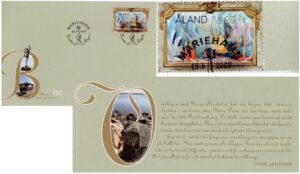
The playful graphic look of the 2009 stamps is the work of Päivi Vainionpää.


The 2011 booklet is from “The book about Moomin, Mymble and Little My”, which was the first book about Moomin and a literary classic of the nursery. It was born in 1951 and was the first work translated into Finnish (previously in Swedish and English). The work was different from other children’s works for its structure and pictorial and typographical experiments. Finnish writer Hannes Korppi-Anttila came up with Finnish names for the characters. The book won several awards. The stamp booklet was created by graphic designer and illustrator Satu Lusa. The cover of the booklet has a sneak peek of the front cover of the book. The stamps (2 sheets) were shaped from the peep holes in the book.
The following Figure shows the FDC’s of 2004 – 2011.


Speech bubbles appear in the 2013 Moomin Favorites booklet, due to the fact that the English newspaper The Evening News required them for Moomin cartoons. As well as all the subjects of the characters are from these comics. In 1959, Tove Jansson transferred the responsibility of producing newspaper comics to her brother Lars Jansson, who continued the work until 1975. The lively and expressive characters in the booklet embody the joy of life. The booklet was made by graphic artist Satu Lusa. Silk lacquer is printed on top of the cartoon characters.

In 2014, the 100th anniversary of Tove Jansson’s birth was celebrated. Two 1st class stamps depict the archipelago where Jansson spent a lot of time since his childhood. In honor of the celebration, stamps were also sold in a separate folder. Similarly, a €2 special euro and €10 and €20 silver commemorative coins were published (pictures below). From the Moomin figures to the stamp, Sniff is depicted as a silhouette in Jansson’s hand. Graphic artist Klaus Welp was responsible for designing the stamps.

The 2015 brand pair reflects the history of Moomin toys, which begins in the 1950s. The designer was Klaus Welp. The characters feature the Hemulen’s aunt, Moomintroll. the Fillyjonk, Sniff, Stinky and Moominpappa. The branded toys are manufactured by Atelier Fauni, which was the first company to manufacture Moomin toys. These hand-made Moomin figures are rare collectibles today.

The set of 5 stamps of 2017 was made for postage abroad. It was made to celebrate the opening of the Moomin Museum (link) in Tampere. Tove Jansson’s original Moomin images have been chosen for brands from different decades, depicting the development of Moomin characters over the years. Ari Lakaniemi and Susanna Rumpu have designed the five foreign permanent brands.
The following Figure shows the first day covers of 2013 – 2017.


The Moomin: advice for a good life stamp booklet published on June 5, 2019 had 6 domestic stamps, each of which presents one of the familiar themes from the Moomin stories: adventure, courage, comfort, freedom, openness and friendship. James Zambra, who belongs to Tove Jansson’s family, was responsible for the graphic design of the stamps. It should be mentioned that one of the brands has the Groke (Mörkö in Finnish) figure (top right), which character was boosted shortly before the publication by Finland’s third ice hockey world championship, key player Marko ”Mörkö” Anttila’s decisive goals in the medal games. For example, a card published by Posti Oyj with the same “Mörkö” (the Groke) image was sold out at the post offices in my hometown Tampere. Similarly, Moomin mugs with the “Mörkö” themes were sold out for a while.

The 2020 brand series was released as part of the #Meidänmeri/#Oursea campaign. At the same time, it is the 75th anniversary of the Moomin stories, in honor of which a series of 21 reissued Moomin mugs with the 75th anniversary mark has also appeared. The theme of the stamps is the protection of the Baltic Sea. The #OURSEA stamp booklet designed by James Zambra has 6 different domestic stamps.
The new ”Moomin ABC” stamps were released in September 2022, which are related to the Moomin Characters company’s campaign promoting reading and writing. The stamps designed by James Zambra show familiar Moomin characters, books and letters on a bookshelf. The Moomin ABC stamp booklet contains 6 different domestic stamps.

”The theme that promotes reading and writing is perfect for stamps, because letters and cards convey self-written messages and feelings from person to person. I believe that Moomins will also encourage new generations to write and read even in stamps” says Posti’s Design Manager Tommi Kantola, who is responsible for selecting the artists for the stamps and directing the stamp artwork.
The following Figure shows the FDC’s of 2019 – 2022.

Other things related to philately
In connection with the publication of Moomin stamps, Posti has also published postcard sets, the motifs of which have often been the same as in the stamp sets. I myself have found card sets from at least 1992, 1994, 1998, 2000, 2003, 2007, 2009, 2011, 2013, 2019, 2020 and 2022 in connection with brand releases. Similarly, the so-called youth pass for the Finlandia 88 stamp exhibition, as well as several postal letters can be parts of Moomin philatelic collection.


For the 2020 “Our Sea” campaign, Paletti published a series of at least 5 Moomin postcards.

Moomin stamps have been used the same as other Finnish stamps. The first series were traditional ones that could be glued by moistening and separated from each other via perforation. Then Finnish Posti moved on to stamps with sticker backgrounds.
So I have been able to collect all the Finnish Moomin stamps in the above described variations, in addition to Åland (2007) and also Japan’s mint publications as sheets (years 2015, 2018 and 2021). I have collected the Finnish Moomin stamps for cards and envelopes as well, so that they either have a first-day cancellation or a special cancellation from the Tampere Moomin Museum. I have also acquired postal items with the special cancellations of Naantali’s Moomin World and Moomin Valley located in Tampere’s Metso library.



Thus, during the Moomin boom, Moomin collectibles include all kinds of things, such as medals, commemorative coins and so-called numisbrief products, i.e. letters with a commemorative coin or medal. In 2004, the so-called numisbrief has been published about the hairy moomin stamp, which includes €10 Tove Jansson commemorative coin. Very many, if not all, of Finland’s euro-era commemorative coins (€2-€100) have been published as numisbrief versions. A good question in itself is whether the numisbriefs are philately: at least they have Posti’s branded postage stamps or personalized postage stamps on them, even with a first-day special cancellation. The numisbrief products were never meant to be transported by mail. Likewise, they are not listed in the stamp catalogs. In many letters, the cancellation also appears to be printed, not stamped. At least, according to their definition, they belong to the side of numismatics.

The Moominvalley stories have been especially enjoyed in Japan, where the Moominvalley Park was opened in 2019. The Moomin specialty mugs sold in the park have also been acquired by Finnish collectors, as well as from resale.
In 2018, queues for the Moomin Day mug, which was available in limited quantities, lasted until the night, and the matter was widely reported in the media. There was similar media publicity for the 2021 Moomin Day mug. There was no Moomin day release between these, probably due to the corona pandemic. The pandemic also messed up the 2021 release so that you couldn’t get the special mug from all Iittala stores. In addition, it turned out that the 2021 mug published in Norway became a more desirable collector’s item. There is an article about Moomin mugs on this portal.
At the time, Tove Jansson did not object to the commercial use of her characters, but only accepted some of the product ideas proposed to her (such as the Moomin toys from the 50s, depicted in 2015 stamps). Today, Moomin Characters Ltd., owned by the Jansson family, controls the rights to use Moomin characters. and I contacted them to ensure the presentation of philatelic products in my own blogs.
Moomin stamps and commemorative coins and medals are certainly one way to gain visibility for the hobby of collecting (philately, numismatics), although of course there is always the risk that quantity replaces quality. For example, Moomin-themed medals and gold coins are produced (Moneta Oy) so much that you can’t keep up with them. Some of them seem to be on very limited sale. Financially, it doesn’t seem to make sense to get them all.
The production of Moomin stamps in Finland will continue as long as new stamps are still issued. As I state in my other blog (link), the number of letters with postage stamps is decreasing all the time and such time will come, when the publication of new stamps is no longer profitable for Finnish Posti Oyj. My guess is around 2025.

